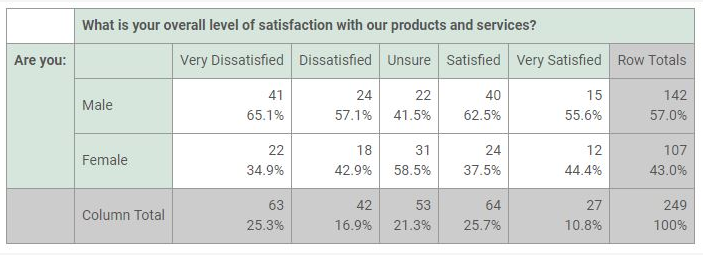Better Analyse Your Survey Results Through Cross Tabulation
Once you’ve collected your online survey results, you’ll want to analyse them as quickly as you can, to see if they are producing the responses you were hoping to see. However, this can be challenging, particularly if you’re dealing with large data sets, where it’s all too easy to get lost in the noise of all the information you’ve collected.
Fortunately, through cross tabulation you’re able to investigate specific data sets at a more granular level and immediately see if there are any patterns or trends in your responses that you expected.
What is Cross Tabulation and how can it help with the analysis of survey results?
Cross tabulations — also known as contingency tables or crosstabs – group variables together to enable researchers to better understand and measure how they relate to each other. When the data for each variable is recorded in a table or matrix and compared, it’s easier to spot any patterns, trends or probabilities.
To help with the analysis of survey response data, cross tabulation reports illustrate the relationship between two or more survey questions, giving you a more detailed comparison of how different groups of respondents answered specific questions.
The results are then typically presented in aggregate data tables to show the total responses to all questions asked in a survey. Cross tabulations tables display not only the results of the entire group of respondents, but also the results from specifically defined subgroups.
For this reason, crosstabs can allow you to closely investigate the relationships within a data set that might otherwise go unnoticed.
An example of a crosstab report is provided below addressing two questions – gender and satisfaction levels.

Three key benefits of Cross Tabulation for survey analysis
1) It reduces the possibility of errors
Analysing large data sets can be confusing and trying to pull valuable insight from them to help inform business decisions can be daunting.
Creating crosstabs can simplify data sets as they divide the total set into representative subgroups, which can then be interpreted at a smaller, more manageable scale. This reduces the potential for errors when analysing data, making the whole process more efficient.
2) Helps uncover more valuable insights:
By reducing your total data sets into more manageable subgroups, cross tabulation helps you to uncover more granular and valuable insights.

For example, the insights you can glean through cross tabulation about the relationships between categorical variables, would be impossible to obtain by digging into the whole data sets. If crosstabs were not created, these insights would probably go unnoticed, or at the very least would require a lot more work to reveal.
3) Your insights are more actionable:
The whole purpose behind statistical analysis of data sets is to uncover actionable insights that will ultimately help you to deliver a business end goal.
These insights are invaluable as they provide hard data to back up your thought processes and decision-making. And because cross tabulation helps to simplify complex data sets, it’s much easier to identify and record valuable insights with this method, while you are developing overarching strategies.
For more advice on Cross Tabulation and details about how to apply a crosstab report to your survey results, take a look at our Cross Tabulation help guide.
Job personas that benefit the most from Cross Tabulation of survey data
While cross tabulation is used across industries and job functions, there are certain personas for whom the insights provided by crosstab analysis is especially beneficial ranging from HR and customer satisfaction managers to marketing and sales directors.
In the area of HR, administering surveys to employees to better understand how they feel about a company, can be particularly helpful for managers looking to measure the health of an organisation’s culture and improve employee engagement. When crosstabs from the resulting response data are analysed it can yield extremely valuable insights about how individuals or specific departments are feeling across different areas, from job satisfaction and departmental efficiency, to organisational culture and overall levels of morale.

Similarly, for customer satisfaction managers who distribute satisfaction surveys to obtain feedback on the goods and services that their organisations provide, crosstab analysis of response data can reveal equivalently impactful insights. This could be particularly valuable when they are trying to evaluate areas such as the varying levels of happiness between new and long-term customers, and the likelihood that these customers would recommend their product or service to their friends or family.
Cross tabulation can also benefit job personas most likely to be involved in market research activities such as marketing, sales directors and any other professionals involved in market research, by allowing them to draw precise, impactful insights from large data sets.
By creating crosstabs, researchers can better identify and evaluate the feelings, perspectives and behaviours of specific subgroups of the population at large, to get a better insight into questions such as: “What is the difference between teens’ and adults’ intent to purchase a particular product?”
Getting more insight from your survey responses with Cross Tabulation
Once you’ve gathered your survey results, you’ll want to be analysing and collecting valuable feedback from them as soon as possible – something that becomes even more critical the more surveys you run. And in today’s time-sensitive marketplace, you’re also under more pressure to deliver faster results, so any tools that can enable you to uncover valuable insights more quickly will be an invaluable. Cross tabulation is a great technique to help you with this, which once incorporated into your data analysis, will not only make your survey response data work harder for you, but uncover the insights that can make a real positive impact for your business.


